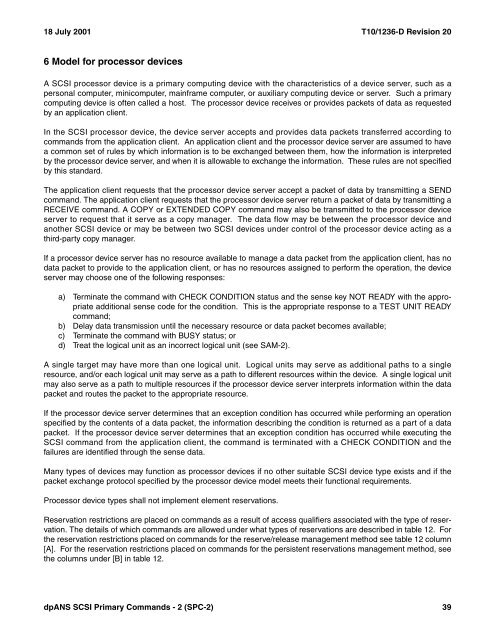SCSI Primary Commands - 2.pdf
SCSI Primary Commands - 2.pdf
SCSI Primary Commands - 2.pdf
- No tags were found...
Create successful ePaper yourself
Turn your PDF publications into a flip-book with our unique Google optimized e-Paper software.
18 July 2001 T10/1236-D Revision 206 Model for processor devicesA <strong>SCSI</strong> processor device is a primary computing device with the characteristics of a device server, such as apersonal computer, minicomputer, mainframe computer, or auxiliary computing device or server. Such a primarycomputing device is often called a host. The processor device receives or provides packets of data as requestedby an application client.In the <strong>SCSI</strong> processor device, the device server accepts and provides data packets transferred according tocommands from the application client. An application client and the processor device server are assumed to havea common set of rules by which information is to be exchanged between them, how the information is interpretedby the processor device server, and when it is allowable to exchange the information. These rules are not specifiedby this standard.The application client requests that the processor device server accept a packet of data by transmitting a SENDcommand. The application client requests that the processor device server return a packet of data by transmitting aRECEIVE command. A COPY or EXTENDED COPY command may also be transmitted to the processor deviceserver to request that it serve as a copy manager. The data flow may be between the processor device andanother <strong>SCSI</strong> device or may be between two <strong>SCSI</strong> devices under control of the processor device acting as athird-party copy manager.If a processor device server has no resource available to manage a data packet from the application client, has nodata packet to provide to the application client, or has no resources assigned to perform the operation, the deviceserver may choose one of the following responses:a) Terminate the command with CHECK CONDITION status and the sense key NOT READY with the appropriateadditional sense code for the condition. This is the appropriate response to a TEST UNIT READYcommand;b) Delay data transmission until the necessary resource or data packet becomes available;c) Terminate the command with BUSY status; ord) Treat the logical unit as an incorrect logical unit (see SAM-2).A single target may have more than one logical unit. Logical units may serve as additional paths to a singleresource, and/or each logical unit may serve as a path to different resources within the device. A single logical unitmay also serve as a path to multiple resources if the processor device server interprets information within the datapacket and routes the packet to the appropriate resource.If the processor device server determines that an exception condition has occurred while performing an operationspecified by the contents of a data packet, the information describing the condition is returned as a part of a datapacket. If the processor device server determines that an exception condition has occurred while executing the<strong>SCSI</strong> command from the application client, the command is terminated with a CHECK CONDITION and thefailures are identified through the sense data.Many types of devices may function as processor devices if no other suitable <strong>SCSI</strong> device type exists and if thepacket exchange protocol specified by the processor device model meets their functional requirements.Processor device types shall not implement element reservations.Reservation restrictions are placed on commands as a result of access qualifiers associated with the type of reservation.The details of which commands are allowed under what types of reservations are described in table 12. Forthe reservation restrictions placed on commands for the reserve/release management method see table 12 column[A]. For the reservation restrictions placed on commands for the persistent reservations management method, seethe columns under [B] in table 12.dpANS <strong>SCSI</strong> <strong>Primary</strong> <strong>Commands</strong> - 2 (SPC-2) 39



![[MS-DFSRH]: DFS Replication Helper Protocol Specification](https://img.yumpu.com/51326226/1/190x245/ms-dfsrh-dfs-replication-helper-protocol-specification.jpg?quality=85)



![[MS-VDS]: Virtual Disk Service (VDS) Protocol Specification](https://img.yumpu.com/50743814/1/190x245/ms-vds-virtual-disk-service-vds-protocol-specification.jpg?quality=85)

![[MS-GPSI]: Group Policy: Software Installation Protocol Extension](https://img.yumpu.com/50703911/1/190x245/ms-gpsi-group-policy-software-installation-protocol-extension.jpg?quality=85)

![[MS-GPPREF]: Group Policy: Preferences Extension Data Structure](https://img.yumpu.com/50206932/1/190x245/ms-gppref-group-policy-preferences-extension-data-structure.jpg?quality=85)





